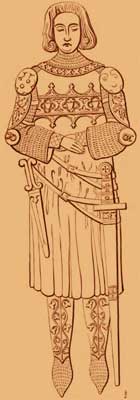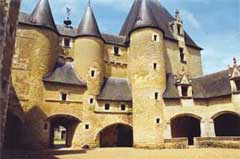The Surcoat – Identifying the Knight's Armor
The military surcoat entered service in the early years of the 13th century. The first English king who appears wearing this garment, as shown on his Great Seal, was King John, who reigned between 1199-1216.

Long Surcoat, c. 1335
Knightly Statue
Church of St. Dominico in Naples
Some writers have suggested that the surcoats were first used during the Crusades in order to prevent the chain mail being heated by the Syrian sun. We are not convinced. What we now for sure is that there is written proof in “The Avowynge of King Arther” stanza 39, that the garment was intended to protect the intricate fabric of chain armor from the wet, as the rusting metal would have played havoc with its serviceability:
"To hold thayre armur clene
And were hitte fro the wete."
The surcoat was initially sleeveless. The sleeved variety appeared in the second half of the 13th century. The sleeveless surcoats could have various lengths, from scarcely covering the hauberk, to being as long as to reach to the heels.
In terms of color, the surcoats were either of a uniform tint, or heraldically pictured. Occasionally they could have an ornamental edge of fringe.
The surcoats was fastened by lacing, buttoning or buckling. The lacing could be at the front, at the back or on the side. In some cases, the garment could be strengthened at the shoulders level, having a rigid appearance across them. Usually it was girt at the waist either with a cord, belt, or strap with a long pendent end. Sometimes it could hang loose. In rare cases, the “surcote” is made with a " fente" at the throat, and fastened with a fibula.
Like the hauberk, the surcoat was slit to the waist in front and behind for convenience on horseback. It was frequently decorated with the armorial bearings of the knight. A special variety was the cyclas. The difference between the surcoat proper and the cyclas is that the former is of even length all round, while the latter is shorter in front than behind.
This intermediate model was a result of the fact that the old, long models were hampering the movements when the knights dismounted to fight on foot. To eliminate the inconvenience, the surcoats were initially clipped in front. As this did not eliminate the problem completely, the necessity dictated a new fashion: the short, tight surcoats, which appeared in the second half of the 14th century.
The preferred materials for surcoats were the camocas, a very popular fabric in the 14th and 15th century, satin, velvet, cloth of gold, or even costly furs.
Even if the surcoat did not protect against blows, it was an essential part of the war equipment of the knight, due to its significance in battle. When the great barrel helm was worn, it was concealing the whole face, making impossible to recognize the person. You can imagine how difficult the problem was, just think that long before the great helm, in the "mêlée" of a Medieval battle, even the simple nasal helmet caused similar problems.
By wearing the surcoat with his colors or armorial bearings, the knight could be easier to recognize on the battlefield. The enrichment of the garment with these heraldic motifs was done by means of elaborate embroidery.
We should note that the surcoat could sometimes be quilted, as that of the Black Prince at Canterbury. The stuffing is cotton, wadded in to a thickness of three-quarters of an inch.


